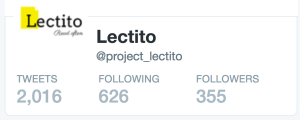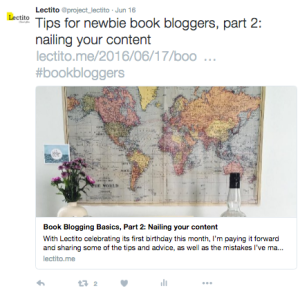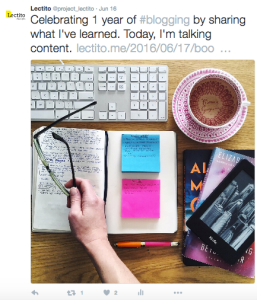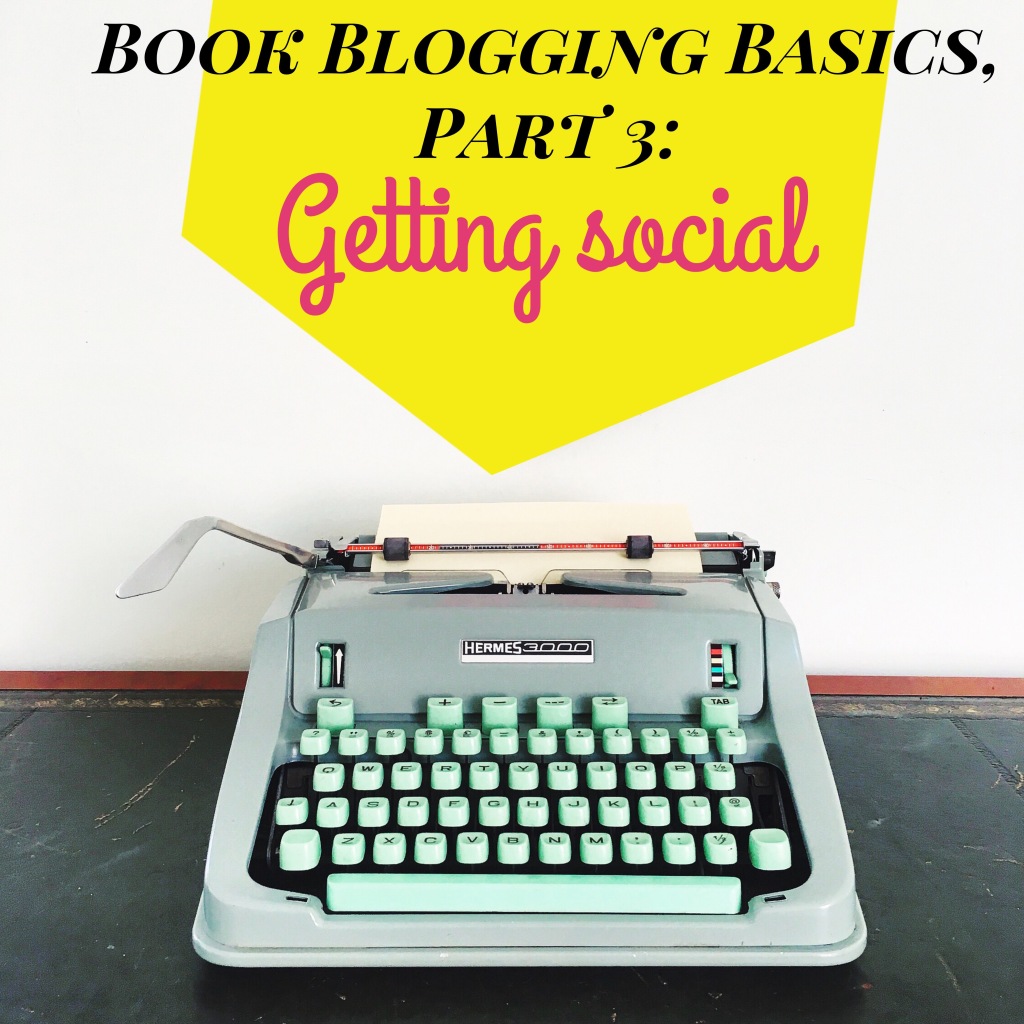With Lectito celebrating its first birthday this month, I’m paying it forward and sharing some of the tips and advice, as well as the mistakes I’ve made and answers to the questions I wish I’d known to ask in my first year of book blogging. Over the past few weeks, I’ve also been chatting with fellow book bloggers to find out what advice they have to share as well as the things they’re still trying to figure out.
In the last two weeks I’ve looked at tips for building a solid base and nailing your content, and next week I’ll be wrapping things up by sharing some advice about innovating and expanding. Don’t want to miss a post? Sign up and get ’em delivered straight to your inbox.
I struggled with what to call this post. I was tempted to go with ‘networking’, but it’s such a clinical, businessy word. I imagine a bunch of people in ill-fitting power suits milling awkwardly around trays of soggy canapes and thrusting business cards at each other. So I settled on ‘getting social’. But this post isn’t just about how to use social media to grow your readership. It’s about making meaningful connections with other readers and becoming an active member of the book blogging community.
If you’re thinking, ‘how does that help my traffic?’ You, my friend, are asking the wrong question. I’ve written about why this approach is a recipe for failure in an earlier post, ‘Why No One’s Reading Your Book Blog (and How to Change That)’, but in short: no blogger is an island. If you want to attract a dedicated and engaged readership, first you need to be a dedicated and engaged reader. The book blogging community is all about quid pro quo. And think about it: you love reading and discussing books, so why wouldn’t you want to chat with other bloggers about what they’re reading? Do you really want to be pumping out reviews in isolation? With no idea who your readers are or what sorts of books they like to read? Where’s the fun in that?
So today I’m going to look at a few of the ways to connect with your fellow book bloggers and use those connections to start building your readership.
Basic etiquette
Before I get stuck into talking about how to be a more social blogger, I want to say a few words about the unofficial code of conduct. Unlike much of the Internet, the book blogging community is by and large a supportive and welcoming space. A good number of us started blogging because we wanted to talk books but weren’t finding those conversations IRL. Maybe we moved to a new city where we didn’t know many people, or maybe we just don’t like leaving the house that much. Whatever the reason, this community is an important space for us, and we want to keep the good vibes happening.
Have opinions, but be respectful about how you express them and remember that there is an actual human being on the other side of the screen. The minute I see ALL CAPS I’m like: ‘This person is deranged. Do not engage.’
Give credit where credit’s due and don’t use other people’s content without permission. Even if you choose to share something by hitting the reblog button, it’s always nice to send the original author an email as well. That way, you can tell them how much you liked their post, let them know where you’re reposting it and introduce yourself while you’re at it. Personally, I’d stick to creating my own content but look for ways to link to other bloggers in my posts. For example, if I read a book based on another blogger’s review, I’d include a link to their review in mine.
If someone follows your blog and/or repeatedly takes the time to leave thoughtful comments on your posts, return the favour by having a look around their site. At the very least, you should take the time to respond to their comments.
Mostly, don’t spam other bloggers. I frequently get people leaving comments like ‘Hey, will you check out my blog?’ Or (mostly on Instagram) ‘F4F?’ (which, for the uninitiated, is ‘follow-for-follow’). It looks desperate. And pathetic. And like you’re only in it for the numbers. The people who will click through and follow? They’re just like you. They’re not interested in reading what you have to say; they just want traffic. And here’s the thing: your stats are meaningless if the readers they represent aren’t actively engaging with your work.
Spend time on other blogs
As with joining a real life community, once your blog is up and running, and you’re all settled in, the first thing to do is start introducing yourself to your neighbours.
When I was asking other bloggers what they’d like to see covered here, a few said they struggled to find other book blogs. It’s true; it can take some searching to find bloggers you click with. And there are a bunch of places to look. I started with the obvious: searching bookish tags in WordPress Reader, but that limits your search to WordPress blogs. I’d also recommend having a hunt around on Bloglovin’ and searching bookish hashtags on social media; you know stuff like, #bookbloggers, #bookblog, #bookreviews, etc. And there’s always Google. Obviously, this approach is going to net you a broad range of results. Narrow your search by thinking about the specific kinds of reviews you’re interested in reading. For example, if Australian YA is your thing, I strongly recommend regularly checking in with the #LoveOzYA tag. Or if your reading list is looking a bit vanilla and you want to mix it up, take a look at #diversebookbloggers. Another great way to find like-minded readers and get involved in some meaty discussions is to search for reviews of titles you’ve reviewed for your blog. It’s also a great way to introduce yourself, as you can respond in detail to other reviewers. You might also be able to offer further reading suggestions (or ask for some) and maybe (subtly) mention that you recently reviewed that title too.
I’ve read a lot of blogs on blogging, and quite a few suggest including links to your posts when you comment on others’ blogs. My advice on this one? Proceed with caution. If you’ve written something that’s relevant to a discussion you’re having with another blogger, and you’re having a genuine conversation with them, not just fishing for clicks, then it might be appropriate. Although when someone drops a link, I often have that moment of: ‘Oh, I thought we were genuinely connecting. Did you just want me to check out your blog?’ And here’s the thing, if someone’s left a thoughtful comment or two and I can see that they’ve taken the trouble to read my work, I’m probably going to head on over to their blog to see what they’re about regardless of whether they’ve asked me to. Ideally, that’s what you should aim for, drawing readers to your blog without issuing explicit invitations.
I recommend regularly putting in the time to seek out new bloggers, but here are just a few of my favourites to get you started:
Be social media savvy
One of the best ways to grow your readership is via social media. However, I see a lot of bloggers putting loads of time into social media and not getting anywhere. I think there are two reasons for this: a) they think social media is just a place for sharing links to their blog or b) they pay waaaay too much attention to their follower count.
When I first started blogging, I saw social media as a series of soap boxes from which to spruik my latest posts. I was all like, TITLE! LINK! #TAG! Then I’d push back my chair and wait for the crowds of readers to stampede upon my blog. They didn’t come. And little wonder. I wasn’t making an effort to interact with anyone. I wasn’t asking questions or responding to their posts. I wasn’t even giving people enough information to know what they’re clicking through to. I was just shouting into the void, like a nutter.
So let me start this section by reiterating the one piece of advice that every social media guru agrees on and most of us cheerfully ignore: social media is social. The argument against this that I see lots of bloggers make is: ‘but I don’t have time to interact with a bunch of other people’s posts. I barely have time to create my own’. Because the rest of us have buckets of free time on our hands and nothing more pressing to do than scroll through Instagram? Please. What makes your content so special that it deserves lashings of praise while you ignore everyone else’s efforts and go about your Very Important Business? If you want people to engage with you on social media, you need to find the time and put in the effort to return the favour. Take a peek at your feed when you’re in line at the supermarket, on the bus, on your lunch break, waiting for the train, during ad breaks, over breakfast, while waiting for your coffee, or while you’re in the bath. Maybe even set aside some time a couple of evenings a week or on the weekend. Basically, get comfortable with the idea that to succeed on social media you need to invest time building relationships with other users. Otherwise, don’t bother.
Now that we understand each other, the first step is to pick the platform(s) you’re comfortable with. In my experience, you’re better off focusing your energy on one or two platforms rather than spreading yourself thin across the board. If you try to do too much, you’ll likely find yourself sinking a lot of time into social media but struggle to make meaningful connections and end up with little to show for your efforts.
My champion platform is Instagram. I usually post once or twice a day and spend a fair bit of time setting up and editing my shots. I also spend a lot of time engaging with other bookstagrammers, as in 10% of my ‘gram time goes towards posting my photos and 90% to interacting with other people’s. I also use Twitter, Facebook, Pinterest and Goodreads, but I don’t put the time into those accounts. For example, I tweet a fair bit, mostly links to my blog and other bloggers’ posts, but I schedule most of my tweets using Tweetdeck and rarely spend time scrolling through my feed and interacting with other tweeters. It shows:
 |
 |
In the grand scheme of things, neither account is blowing up the Internet, but I have more than 10x the number of followers on Instagram as I do on Twitter! But as I said before, it’s not really about followers. Because followers only count if they engage with your content, i.e. they like and comment on your posts, click your links and buy your products (if you’ve monetised your blog). (Side note: this is why you shouldn’t pay for followers. Here’s an article from Racked explaining a little more about that.) When it comes to engagement, the time I put into Instagram pays off even more. For example, for last week’s post on nailing your content, I posted two tweets:
 |
 |
They attracted a few retweets and a couple of other bloggers kindly tweeted about the post too. About 20 readers clicked through to the post from Twitter. Not bad, considering how little effort I put in. I also posted about it on Instagram:

More than 100 people clicked through. Much better! But that’s only because I love hanging out on Instagram, and I’ve been willing to put in the time.
The takeaway from all this? You can and should go out and learn about peak posting times, what kinds of posts work best for what platforms, how to schedule posts, use hashtags, etc. But all of that will only get you so far. The most important thing is to interact with other users and build genuine relationships. If you’re just starting out and looking for people to connect with on Instagram, take a peek at my Meet the Bookstagrammers series, where I interview some of my favourite ‘grammers, and also:
- Bookstagram: 20 Instagram accounts for book lovers
- Bookstagram Revisited: 25 (more) accounts that make reading look good
- 30 Fave Bookstagrammers
Get engaged
I keep banging on about taking the time to engage with other bloggers. But what does that mean exactly, and what’s the best way to go about it? The easiest way is simply to like other bloggers’ posts, whether that be on their blog or social media. And likes are nice. They give us warm fuzzies, maybe a little confidence boost, but beyond that, they don’t mean a whole lot. You don’t have to think about ’em. You just hit a button. They also don’t prove that you’ve absorbed the content of a post. Basically, likes are cheap.
Comments, on the other hand, are gold. And I don’t mean the generic ‘Good post!’ or ‘Great pic!’ I mean comments that show you’ve read and thought about what the other blogger is saying. Bloggers are more likely to show an interest in you if you show a genuine interest in them. More than that, starting conversations with other bloggers is the first step in building meaningful and mutually beneficial relationships. Down the track, if you want to run a blog tour or a reading challenge, or you’re keen to start a book club or collaborate with other bloggers in any way, that’s going to be a whole lot easier if you already have some friends in the blogosphere. Friends are also more likely to give shout outs, share posts and help each other out. For example, when I was choosing Instagram accounts to include in my 30 Fave Bookstagrammers post and considering which blogs to recommend in this post, I thought first of the bloggers I’ve developed a strong relationship with, or want to have a better relationship with.
To be clear, I’m not suggesting you write essay-length responses to every post you read, or even that you necessarily comment on each post. If you follow a large number of bloggers, that’s likely not even possible. Nor am I saying that you shouldn’t like posts, only that there’s not a whole lot of point in sinking hours and hours each week into merely liking posts and leaving the occasional ‘Great stuff!’.
#Squadgoals
Blogging becomes a whole lot more fun once you’ve made some friends. It’s like the beginning of high school all over again, and you’ve found a group to sit with at lunch. You’re no longer writing for a silent, unseen audience—there are familiar faces in the stalls! And you’ve got a bunch of other blogs to check in with too. You’re sharing book recommendations and having real discussions about reading. Most importantly, you’re not alone in this anymore. Now you can start to work together and give each other a leg up. Share each other’s posts, collaborate on blog tours and reading challenges, write guest content for each other, start an online book club, or dream up a whole new project to work on.
By nature, I’m a lone wolf. Networking (there’s that icky word again) doesn’t come naturally to me at all. So often I’ll read another blogger’s post and enjoy it, but I don’t naturally think to comment on it or share it. When I first started out, I also had this weird idea that other bloggers wouldn’t want me commenting because what I had to say wasn’t good enough or that I was annoying them somehow. Which is so stoopid, because I love it when people comment on my blog. So last month, I gave myself a kick up the bum (don’t think too hard about how that works) and focused on building relationships. I made more of an effort to comment on other bloggers’ reviews and Instagram posts and to link to and share their content. I published Q & As with six bookstagrammers I admire, took part in my first blog tour and made sure I tagged authors and publishers when tweeting/Instagramming reviews. I also reached out to a few publishers I’d been nervous about approaching and even paired up with JORD Wood Watches to review my first non-book product. The result? Well, for a start, my traffic shot up:

More importantly, I made a bunch of new friends, got to know some familiar faces a little better, received some much yearned for ARCs and had the opportunity to interview one of my favourite authors. Best of all, I had fun! It was by far my most enjoyable month of blogging to date. I was in constant conversation with other bloggers, it felt like things were moving and happening and I was excited about reading and working on Lectito.
Recap
We all want readers. If we didn’t, we’d just keep a diary, right? There are thousands of bloggers out there who will promise you that with solid, SEO-rich content and regular social media updates, you will be pulling in hundreds of thousands of readers (and dollars) practically overnight. And if you can’t, you’ve failed. That’s bullshit! Growing a loyal readership takes years, not weeks or months, and you need to be willing to put in the time and effort along the way. But more than that, you can’t succeed alone. As in any business, or really any situation where you interact with other people, developing strong and positive relationships within the community is key. Good relationships bring unexpected opportunities and support, and most importantly, they make blogging fun.
Stick around, next week I’m finishing off this series by talking innovation and expansion, including how to build relationships with publishers and authors, adapt and repurpose your content across multiple platforms, streamline the blogging process and expand your blogging horizons.
If you found this helpful, take a peek at the other posts in the series:
- Book Blogging Basics, Part 1: Building a solid base
- Book Blogging Basics, Part 2: Nailing your content
- Book Blogging Basics, Part 4: Innovating and expanding
—Margot XO
Like what you see? Get the latest from Lectito delivered to your inbox.



